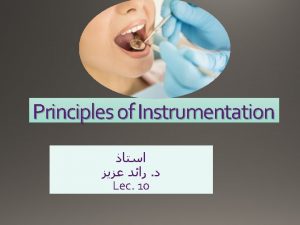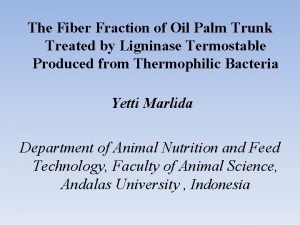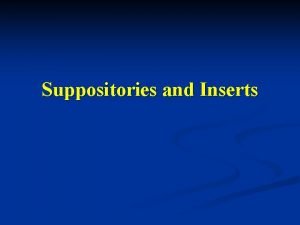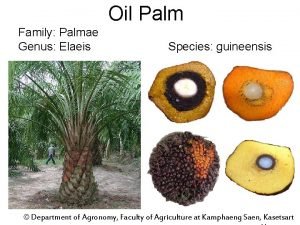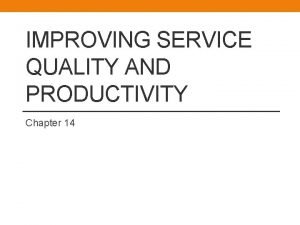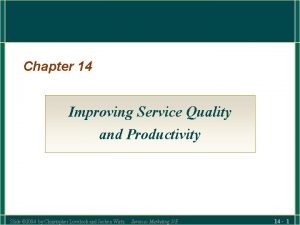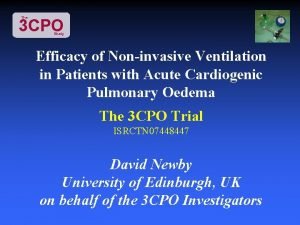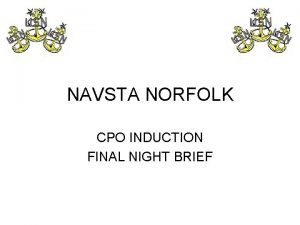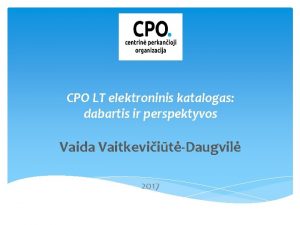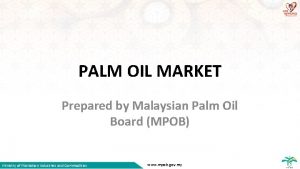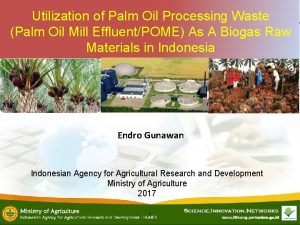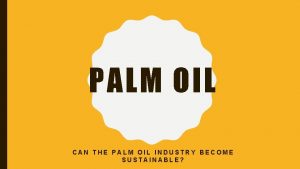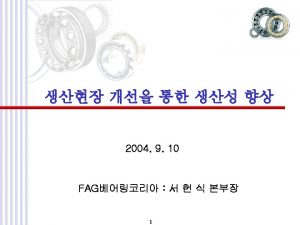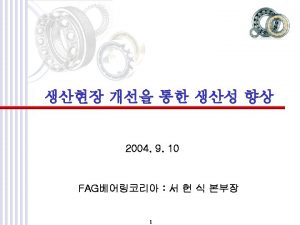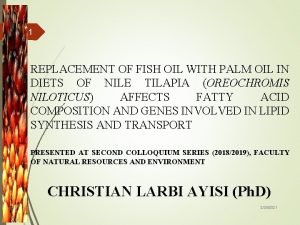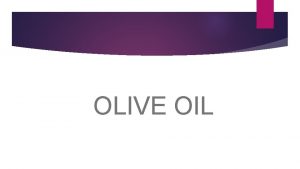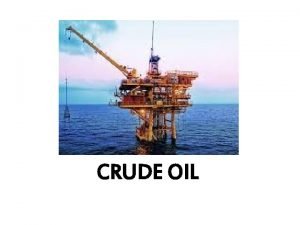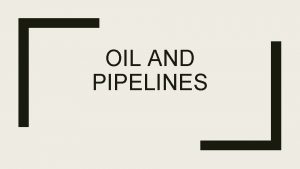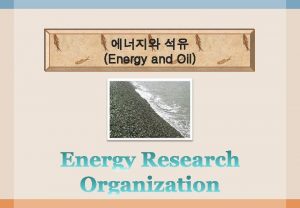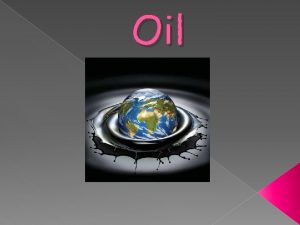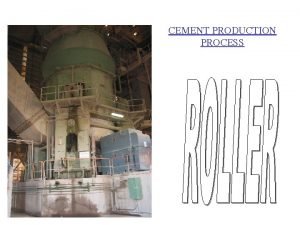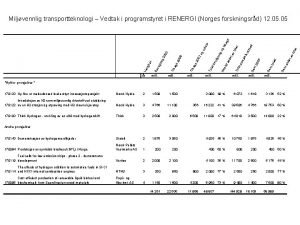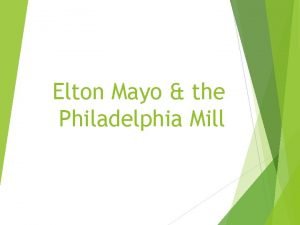Improving CPO Quality in the Palm Oil Mill














































- Slides: 46

Improving CPO Quality in the Palm Oil Mill and Best Practices to Mitigate 3 -MCPD in CPO Wet Processing The Malaysian Oil Scientists’ & Technologists’ Association (Mosta) FRANK SCHOENING, PETALING JAYA, JULY 19

Agenda 1 Introduction of GEA and scope of supply for CPO processing 2 Palm oil – figures and quality standards 3 Current discussion about MCPD and GE 4 Mitigation strategies for the oil mill • Conventional process • ECO-D process • CPO washing 5 Process changes for refining palm oil 6 Conclusions Palm Oil 2

Agenda 1 Introduction of GEA and scope of supply for CPO processing 2 Palm oil – figures and quality standards 3 Current discussion about MCPD and GE 4 Mitigation strategies for the oil mill • Conventional process • ECO-D process • CPO washing 5 Process changes for refining palm oil 6 Conclusions Palm Oil 3

GEA – “engineering for a better world” Order intake (EUR) 4, 674 million Employees (FTEs) 16, 937 Operating EBITDA (EUR) 566 million Operating EBITDA margin GEA is one of the largest suppliers of process technology for the food industry and a wide range of other industries. The international technology group focuses on process technology and components for sophisticated production processes in various end-user markets. The company is listed on the German MDAX stock index and included in the STOXX® Europe 600 Index. In addition, the company is listed in selected MSCI Global Sustainability Indices. 12. 6% 4, 491 million Earnings per share (EUR) 1. 48 Palm Oil 4

Our applications – in touch with GEA every day Dairy Farming and Processing Approx. one quarter of processed milk comes from GEA production systems Every fourth liter of human blood is handled by GEA equipment Every third chicken nugget is produced by GEA technology More than one third of all polymer producer are using GEA Drying technology Chemical Each industry we serve utilizes GEA’s industrial refrigeration technologies Utilities Every second container ship in the world sails with GEA marine equipment on board Marine Food Around every third process line for instant coffee was installed by GEA At least every third liter of edible oil worldwide has been refined with GEA separators Beverages Palm Oil Pharma Approx. every second liter of beer is brewed with the aid of systems and process solutions from GEA 5

PG Separation - Core Products Separator centrifuges Decanter centrifuges with bowl diameters from 200 mm up to 1050 mm with bowl diameters from 200 mm up to 1030 mm Throughput capacity up to 500, 000 l/h Particle size from 0, 5 µm Palm Oil Throughput capacity up to 350, 000 l/h Particle size from 5 µm 6

Processing of Crude Palm Oil GEA is supplying process know-how and equipment for the following processes: Ø Conventional process Ø Crude oil process Ø Ecod- process Ø Oil recovery from POME Ø CPO washing in the mill Ø Chemical refining Two and three-phase decanters De-sanding systems 7 Oil Palm Nozzle separators Brush strainer Purifier CPO Washing Vacuum Dryer Refining separator

Agenda 1 GEA and CPO production 2 Palm oil – figures and quality standards 3 Current discussion about MCPD and GE 4 Mitigation strategies for the oil mill • Conventional process • ECO-D process • CPO washing 5 Process changes for refining palm oil 6 Conclusions Palm Oil 8

Importance of Palm Oil 6% 4% 90% Palm Oil is the vegetable oil with the highest level of production in the world. In 2016 around 62 Mio tons were produced. The oil palm grows best in tropical countries with constant climate. Palm Oil 9

Estimated global palm oil production by countries Rank 1 2 3 4 5 6 7 8 9 10 11 12 13 14 15 16 17 18 19 20 21 22 23 24 25 Palm Oil Country Production [1000 MT] Indonesia 35. 000, 00 Malaysia 21. 000, 00 Thailand 2. 300, 00 Colombia 1. 175, 00 Nigeria 970, 00 Ecuador 560, 00 Honduras 545, 00 Papua New Guinea 522, 00 Ghana 520, 00 Guatemala 515, 00 Côte d'Ivoire 415, 00 Brazil 340, 00 Cameroon 270, 00 Costa Rica 270, 00 DR of the Congo 215, 00 Mexico 110, 00 Philippines 85, 00 Angola 58, 00 Dominican Republic 53, 00 Peru 51, 00 Benin 50, 00 Guinea 50, 00 Liberia 42, 00 Sierra Leone 36, 00 Venezuela 15, 00 Total 65. 167, 00 Region [1000 MT] South East Asia [%] 58. 907 90 Latin America 3. 581 6 Africa 2. 679 4 Source: US Department of Agriculture, Year of estimate 2016 10

What means improving palm oil quality today? Oil Mill The focus in the mill is to achieve maximum yield and to produce CPO within the standard quality specification, which is: Ø FFA below 5% Ø Moisture and impurities below 0. 25% Ø Deterioration of bleachability index (DOBI) 2. 3 MIN (3. 0 is a very good value) Ø Normally a premium is paid for CPO with very low FFA to ensure low refining loss Causes of low DOBI and poor CPO oil quality: Ø Unripe fruit bunches Ø Delay in fruit processing (raining season) Ø Contamination of CPO with badly oxidised sludge oil Ø Prolonged sterilisation time Ø Over heating and prolonged retention time in vertical clarifier tank Ø High dilution rate and high moisture content Ø Long processing time in the mill Palm Oil 11

What means improving palm oil quality today? Refinery So far physical refining is the most common process: CPO Ø 0. 1% FFA (as palmitic) for RBD Ø Moisture and Impurities 0. 1% max. Ø Colour 3 or 6 red max. Bleaching Features of physical refining Ø Removal of gums and undesired components in the dry degumming process due to conditioning with citric acid in the bleaching step with activated bleaching earth Ø Bleaching earth consumption around 8 kg/t CPO Ø Removal of color, gums and undesired components by bleaching Ø Odor/ smell and removal of FFA in the deodorization step at high Deodorization RBD palm oil Palm Oil temperature with significant influence on the formation of 3 -MPCD esters Palm Oil 12

Agenda 1 Introduction of GEA and scope of supply for CPO processing 2 Palm oil – figures and quality standards 3 Current discussion about MCPD and GE 4 Mitigation strategies for the oil mill • Conventional process • ECO-D process • CPO washing 5 Process changes for refining palm oil 6 Conclusions Palm Oil 13

Potential of different edible oils to form 3 -MCPD and glycidil ester Total production of edible oils in 2016: 180 Mio. t PKO 4% 4 others 9% 3, 5 Palm oil 35% Sunflower 9% Rapeseed 14% mg/kg (Median) 3 2, 5 2 1, 5 1 0, 5 0 Palm oil Soy 29% Soy Rapeseed Sunflower 3 -MCPD GE Source: USDA Statista Palm Oil Source: EFSA 14

Current status palm oil Food safety discussions about 3 -MCPD and GE Ø Comparably high content of MCPD and GE in palm oil Ø MCPD and GE are suspected to be carcinogenic and genotoxic Ø High pressure on food producers Ø EFSA has been requested by the EU Commission for a risk assessment Ø EFSA recommendation for TDI: 3 -MCPD: 0. 8 µg/kg bw Ø On discussion at EU level: • 3 -MCPD: 2 ppm (perspective < 1 ppm in future) • GE: 1 ppm Ø Consumer groups and food safety organizations demand lowest possible concentration in refined oils Palm Oil 15

Value chain and production flow in palm oil processing Plantation Breeding Cultivation Harvest Storage and transportation Oil mill CPO recovery process Storage and transportation Refinery 16 Physical refining Palm Oil RBD Storage and transportation 16

Mitigation strategies Plantation Mill Refining MCPD & Glycidyl Esters Avoiding (removal) of precursors Palm Oil Removing of esters 17

Causes of 3 -MCPD and GE creation in palm oil processing Precursor for the creation of 3 -MCPD in palm oil is primarily chloride Sources of chloride: Ø Fertilizers Ø Soil Ø Steam Condensate ØSludge oil Palm Oil 18

Agenda 1 Introduction of GEA and scope of supply for CPO processing 2 Palm oil – figures and quality standards 3 Current discussion about MCPD and GE 4 Mitigation strategies for the oil mill • Conventional process • ECO-D process • CPO washing 5 Process changes for refining palm oil 6 Conclusions Palm Oil 19

How to mitigate the esters in palm oil Plantation • Breeding • Cultivation • Harvest • Storage and Transport Avoiding or removing of precursors Ø FFB are not suitable for storage Ø Metabolic process starts directly after harvesting → Formation of FFA and Diglycerides Getting lowest diacylglycerols (DAGs) content Ø Harvest at optimum ripeness Minimization of chloride containing substances in cultivation Ø Pesticides Ø Fertilizer Palm Oil 20

How to mitigate the esters in palm oil Oil mill • Sterilization • CPO production process • Storage and Transport Avoiding or removing of precursors Ø Shortest possible processing time in the mill → Formation of FFA and Diglycerides Ø No circulation of low grade oil Getting lowest diacylglycerols (DAGs) content Ø Shortest possible sterilization time Ø Use steam without chloride Minimization of chloride containing substances Ø Washing of FFB to remove chloride Ø Additional washing of CPO, ev. with slightly alkaline water Palm Oil 21

Agenda 1 Introduction of GEA and scope of supply for CPO processing 2 Palm oil – figures and quality standards 3 Current discussion about MCPD and GE 4 Mitigation strategies for the oil mill • Conventional process • ECO-D process • CPO washing 5 Process changes for refining palm oil 6 Conclusions Palm Oil 22

Comparison different processes Conventional Process Dilution 20 -40% to FFB Palm fruits Dilution Press Sand trap Sludge Dilution Fibres Vibrating screen Live Steam Buffer tank Condensate Top oil Steam Live Steam Sludge tank Oil tank Sand De-sanding Purifier Sludge Vacuum dryer Oil to storage Live Steam Cake Waste water to effluent Palm Oil Steam Vertical clarifier Feed tank 3 -phase decanter Oil 23

Comparison different processes The following centrifuges for sludge de-oiling are available in the market: Ø Star Bowl Centrifuges (low speed) Ø Nozzle Separators Ø 3 - phase Decanters Palm Oil 24

Low Speed / Star- bowl centrifuge Ø Ø H 2 O Feed Oil + H 2 O + Emulsion Drain Palm Oil 25 Low speed horizontal separator 1, 500 rpm 2 -Phase machine Needs high amount of dilution water Permanent supervision is necessary to avoid oil losses Ø Discharged oil quality is poor higher recirculation Ø High power consumption

Nozzle Separator DA 45 Ø More effective, 3 -phase machine, 5, 400 rpm Ø The separation efficiency can be adjusted Ø Stable separation with discharge of the liquids under pressure Ø No need for manual adjustment even if the feed composition changes Palm Oil 26

3 -Phase Decanter Feed Palm oil Solids Palm Oil 27 Water

3 -Phase Decanter Spin Tests from Conventional Process - Oil discharge - Decanter feed - Water discharge - Cake Palm Oil 28

3 -Phase Decanter More attractive compared to the other systems for the sludge de-oiling, because Ø Ø Ø Palm Oil 29 No need for manual cleaning or CIP The solids are leaving the decanter continuously Lower solids content in the waste water Low water consumption, based on higher solid content of the feed Handling of solid enriched feed with higher viscosity is possible

Comparison different processes Centrifuges available for sludge de-oiling Star Bowl Centrifuge Nozzle Separator 3 Phase Decanter Oil content in light phase 30 % 80 % Dilution water consumption High Medium Low Slurry, contains all nutrients Slurry, contains Discharged all nutrients as cake Availability due to nozzle blockage Very low Good with CIP Very good Handling Complicated Easy Oil losses in the heavy phase Medium/high Low Labor-intensity High Medium/low Low Price (investment) Very low Medium High Solids discharge Palm Oil 30

Agenda 1 Introduction of GEA and scope of supply for CPO processing 2 Palm oil – figures and quality standards 3 Current discussion about MCPD and GE 4 Mitigation strategies for the oil mill • Conventional process • ECO-D process • CPO washing 5 Process changes for refining palm oil 6 Conclusions Palm Oil 31

ECO-D Process Dilution 0 -5 % to FFB Palm Oil

ECO-D Process Operating conditions Feed Slurry § 0 - traces § 0 - 10 Vol % § 90 - 100 Vol % § ~ 14 % Palm Oil Emulsion Water Solids NOS Light Phase • 95 - 99 Vol % Oil • 1 - 5 Vol % Emulsion Feed: Crude palm oil • 50 - 55 v/v % Oil • 1 - 7 v/v % Water • 40 - 45 v/v % Solids • ~ 8 w/w % NOS • temperature min. 95°C

ECO-D Process Available Decanters and capacities for ECO-D Palm Oil Type CA 501 -08 -50 VCC 469 -08 -50 Feed Capacity 15 m³/h 18 m³/h FFB Capacity 30 -35 t/h FFB 38 -40 t/h FFB Oil loss 0. 35% to FFB Oil to DM 10 -12%

Differences between conventional and ecod process Conventional palm oil ecod Process process Palm Oil Dilution water 20 -25 % to FFB < 5% to FFB Oil losses min. 0. 4 % to FFB 0. 35 -0. 38 % to FFB FFA 0. 6 -0. 8 % more than ECO- D approx. 3% Retention time 8 -10 h in settling tank 1 hour Required space high low POME/slurry 0. 65 m³/t FFB 0. 45 m³/t FFB 35

ECO-D Process ECO-D - A System for the Future Ø Direct crude oil processing without vertical clarifier tank. Ø Shorter processing route, product exposure to heat is substantially reduced. Ø Best quality oil compared with conventional process is achieved. Ø Ecological and simplified process without dilution water. Ø Reduction in hot water consumption, energy and treatment costs substantial cost savings. Ø As no dilution water is required, the resultant effluent slurry is reduced to 15 ~ 20 % to FFB. Ø Lower oil losses compared to conventional process, resulting in substantial savings. Palm Oil 36

Agenda 1 Introduction of GEA and scope of supply for CPO processing 2 Palm oil – figures and quality standards 3 Current discussion about MCPD and GE 4 Mitigation strategies for the oil mill • Conventional process • ECO-D process • CPO washing 5 Process changes for refining palm oil 6 Conclusions Palm Oil 37

Total chloride levels in palm oil products today Sample Average value (ppm) Range (ppm) Crude palm oil 7. 29 (± 5. 9) 2. 62 -15. 58 RBD palm oil 2. 46 (± 0. 9) 1. 08 -3. 51 RBD palm olein 2. 30 (± 1. 1) 1. 21 -3. 72 RBD palm stearin 1. 89 (± 1. 1) 0. 15 -3. 10 Source: MPOB Palm Oil 38

CPO Washing Features: Ø Maximum extraction of chlorides in the mill Ø Mitigation of 3 MCPD esters in the refinery Ø Removal of other contaminants (e. g. phospholipids) Ø Best oil quality by oil cooling before storage Process target: • Reduce inorganic chloride content from 8 ppm to 2 ppm Palm Oil 39

Agenda 1 Introduction of GEA and scope of supply for CPO processing 2 Palm oil – figures and quality standards 3 Current discussion about MCPD and GE 4 Mitigation strategies for the oil mill • Conventional process • ECO-D process • CPO washing 5 Process changes for refining palm oil 6 Conclusions Palm Oil 40

How to mitigate the esters in palm oil Refinery Change from physical to chemical refining Ø 2 -stage neutralization for best possible oil quality Lower temperatures in deodorization stage lead to lower GE content Ø Only a chemically neutralized oil allows lower temperatures in the downstream deodorizing stage. Very high deodorization temperatures create GE Minimization of chloride Ø Minimization of the chlorides with the aid of sodium hydroxide produces the best results in the reduction of 3 -MCPD and thus less contamination with 3 -MCPD esters Palm Oil 41

Chemical Refining / 2 -Stage Neutralisation Features: • Reliable process, even for worst crude oil qualities • Can be also used for washing only in case of top CPO quality Process achievements: • FFA content: < 0, 1 % • Soap content: < 100 ppm • 3 MCPD mitigation: < 1 ppm possible Palm Oil 42

Additional advantages of chemical refining vs physical refining Ø Longer shelf life due to metal ions removal (higher oxidation stability) Ø Removal of unwanted color pigments Ø Reduction of bleaching earth consumption (up to 50%) Ø Lower temperature in deodorizer possible (< 220°C as opposed to 260 -280°C) Ø Effect of lower temperature: Mitigation of GE and 3 MCPD esters Ø Premium price for chemically refined palm oil Ø Soapstock is a by-product (soap production, fatty acid recovery by splitting) Palm Oil 43

Agenda 1 Introduction of GEA and scope of supply for CPO processing 2 Palm oil – figures and quality standards 3 Current discussion about MCPD and GE 4 Mitigation strategies for the oil mill • Conventional process • ECO-D process • CPO washing 5 Process changes for refining palm oil 6 Conclusions Palm Oil 44

Summary and Conclusions Ø If you want to minimize MCPD and GE in palm oil, you have to start as Ø Ø Ø Palm Oil early in the process as possible The most crucial factors in the mill are: oil quality and chloride content That makes ECO-D best process in terms of MCPD and GE mitigation (due to its shortest processing time, no dilution water and lowest FFA content For all conventional processes: use 3 -phase decanter due to lowest re -circulation volumes Use low quality oil only for producing oleo chemicals or biofuels Integrate CPO washing in your mill Change from physical to chemical refining 45

gea. com
 Mutoharoh
Mutoharoh Protea senior living
Protea senior living Principles of instrumentation
Principles of instrumentation Adiantum spp.
Adiantum spp. Oil palm trunk fiber
Oil palm trunk fiber Advantages and disadvantages of palm oil
Advantages and disadvantages of palm oil Oil palm
Oil palm Family name of oil palm
Family name of oil palm Listening gap communication
Listening gap communication Gaps model for improving service quality
Gaps model for improving service quality Improving service quality and productivity ppt
Improving service quality and productivity ppt Difficulties of improving quality
Difficulties of improving quality Difference between creaming and cracking of emulsion
Difference between creaming and cracking of emulsion Cpo respiratory
Cpo respiratory Cpo mvgp
Cpo mvgp Cpo final night
Cpo final night Cpo rising
Cpo rising Cpo food closet
Cpo food closet Cpo katalogas
Cpo katalogas Cpo eval bullets
Cpo eval bullets Hypotheek cpo
Hypotheek cpo Niada cpo
Niada cpo Quality is free
Quality is free Quality control and quality assurance
Quality control and quality assurance Compliance vs quality
Compliance vs quality Pmp quality management
Pmp quality management Old quality vs new quality
Old quality vs new quality Basic concept of quality management
Basic concept of quality management Pmbok quality assurance vs quality control
Pmbok quality assurance vs quality control Philip crosby formulated the seven deadly diseases
Philip crosby formulated the seven deadly diseases Define seminar in nursing management
Define seminar in nursing management Một số thể thơ truyền thống
Một số thể thơ truyền thống Thế nào là hệ số cao nhất
Thế nào là hệ số cao nhất Slidetodoc
Slidetodoc Hệ hô hấp
Hệ hô hấp Số nguyên tố là số gì
Số nguyên tố là số gì đặc điểm cơ thể của người tối cổ
đặc điểm cơ thể của người tối cổ Mật thư anh em như thể tay chân
Mật thư anh em như thể tay chân Các châu lục và đại dương trên thế giới
Các châu lục và đại dương trên thế giới Chụp phim tư thế worms-breton
Chụp phim tư thế worms-breton ưu thế lai là gì
ưu thế lai là gì Thẻ vin
Thẻ vin Tư thế ngồi viết
Tư thế ngồi viết Bàn tay mà dây bẩn
Bàn tay mà dây bẩn Các châu lục và đại dương trên thế giới
Các châu lục và đại dương trên thế giới Từ ngữ thể hiện lòng nhân hậu
Từ ngữ thể hiện lòng nhân hậu Bổ thể
Bổ thể


